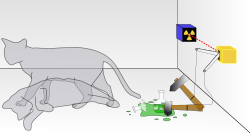Thought experiment
This article may not have a worldwide view of the subject. |
A thought experiment is an experiment that takes place in people's minds instead of in a laboratory or in the real world. In a real-life experiment, people can see and measure changes, but thought experiments only show special ways of thinking. Anyone can do a thought experiment.
The usual goal of a thought experiment is to show what might happen: if this were true, what would follow from it?
The history of science has many thought experiments in it. Hans Christian Ørsted was the first to use the German term Gedankenexperiment (means 'thought experiment') in about 1812.[1]
Posing hypothetical questions had been done for long time (by scientists and philosophers).[2][3] However, people had no way of talking about it.
Famous thought experiments
Thought Experiment Media
Schrödinger's cat (1935) presents a cat that is in a superposition of alive and dead states, depending on a random quantum event. It illustrates the counter-intuitive implications of Bohr's Copenhagen interpretation when applied to everyday objects.
References
- ↑ Witt-Hansen (1976). Although Experiment is a German word, it is derived from Latin. The synonym Versuch has purely Germanic roots.
- ↑ Sorensen R.A. 1992. Thought Experiments. Oxford University Press.
- ↑ Horowitz T. & Massey G.J. (eds) 1991. Thought experiments in science and philosophy. Rowman & Littlefield.








